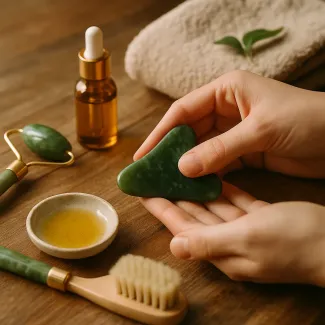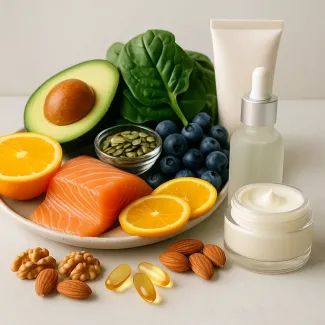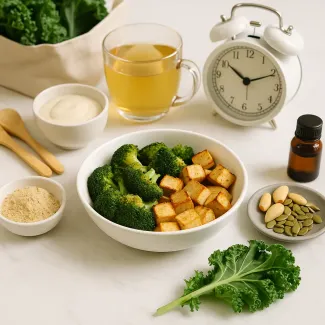
Ancient Beauty Wisdom Revived for Modern Skin Vitality
Unlocking the regenerative secrets of Japanese facial care techniques
Japan’s enduring approach to beauty and wellness has long captivated the world, and one technique in particular is gaining renewed interest: the Japanese face-lifting method. This traditional yet powerful practice blends mindful touch, muscle activation, and circulatory stimulation to encourage natural rejuvenation, improve skin elasticity, and promote a more sculpted, youthful look without any invasive procedures. In an age where skincare is becoming more personalized, gentle, and holistic, this method offers a unique combination of simplicity, consistency, and results.
Whether you are in your 30s aiming to preserve skin vitality, in your 40s navigating hormonal shifts, or in your 50s and beyond embracing graceful aging, this method can support your skin’s evolving needs through consistent, intentional self-care. Let’s explore how this technique works, how to apply it in your routine, and why it’s becoming a global wellness essential.
The philosophy behind Japanese facial care
Japanese beauty traditions are rooted in balance, harmony, and prevention. The core idea is to support the skin’s natural functions rather than override them with harsh treatments. In the case of face-lifting techniques, this means stimulating blood flow, improving lymphatic drainage, and strengthening facial muscles — all of which contribute to better skin tone and structure.
These techniques are often practiced with the aid of natural oils, facial serums, or simply clean hands, and they emphasize regularity over intensity. By encouraging daily rituals, they foster long-term transformation rather than overnight changes.
What is the Japanese face-lifting technique?
Also known as facial massage lifting, this technique focuses on manual manipulation of the skin and underlying muscles. Using specific motions — lifting strokes, circular kneading, gentle tapping — the technique activates stagnant areas, encourages detoxification, and lifts the skin from within.
The practice also enhances oxygen delivery to skin tissues, resulting in a more radiant and even complexion. It is particularly effective in areas where sagging tends to begin first, such as the jawline, cheeks, nasolabial folds, and brow area.
Key benefits for skin health and aging
Adopting this technique as part of your regular self-care routine can bring visible and lasting benefits:
- Improved skin firmness and contour definition
- Reduction of puffiness and dark circles under the eyes
- Enhanced collagen production through circulation
- Smoother expression lines and fine wrinkles
- Relaxation of facial tension, particularly in the jaw and forehead
- Boosted skin hydration and glow due to better product absorption
It’s a non-invasive way to tap into your body’s own mechanisms for skin regeneration.
Techniques that align with the Japanese lifting approach
There are several recognized techniques within the Japanese facial care canon that form the foundation of natural lifting:
Ko Bi Do massage
An ancient technique used by Japanese nobility, Ko Bi Do combines acupressure, drainage, and toning movements to create a lifting effect while supporting internal balance. It’s often performed in facial spas but can be adapted for home use.
Tanaka facial massage
Developed by Japanese beauty expert Yukuko Tanaka, this method focuses on lymphatic drainage and facial symmetry. The massage reduces swelling and tightens sagging skin through a structured series of strokes and pressure points.
Face yoga
Face yoga, or facial exercise, complements lifting techniques by building muscle tone under the skin. Movements involve smiling stretches, cheek lifts, and resistance-based motions designed to target areas prone to sagging.
Choosing the right tools and products
Though you can perform the Japanese face-lifting technique with just your fingers, certain traditional and modern tools can enhance the experience and outcome:
- Gua sha: The smooth stone tool helps glide along facial lines and release tension
- Jade roller: Cool and soothing, it supports lymph flow and reduces puffiness
- Boar bristle facial brush: Used dry, it stimulates circulation before massage
- Camellia oil: A prized Japanese skincare oil rich in oleic acid and antioxidants
- Fermented rice serums: Nourish and hydrate while allowing massage to glide easily
Consistency and quality of movement are more important than any one product. Always work in an upward and outward motion, with clean hands and a clean face.
When to begin and how often to practice
Starting early — even in your early 30s — provides a preventive effect by supporting skin structure before deeper lines set in. However, it’s never too late to benefit. Even women and men in their 60s and beyond report noticeable improvements in skin tone, relaxation, and complexion brightness after just a few weeks of daily practice.
The ideal frequency is once per day, preferably in the evening when you are unwinding and have removed makeup or SPF. It pairs well with your nighttime skincare routine and helps deepen sleep by relieving facial tension.
How this technique supports the hormonal system and energy
Facial massage isn’t just about appearance. The lymphatic and circulatory stimulation also contributes to hormonal regulation, particularly in the thyroid and adrenal zones of the neck and jaw. This supports the body’s natural detoxification and improves energy balance.
Furthermore, many users report better mental clarity, reduced anxiety, and less facial tension after consistent practice. That’s because facial nerves are linked to parasympathetic activation, helping calm the nervous system through mindful touch.
Common mistakes and how to avoid them
To maximize the benefits of the Japanese face-lifting technique, avoid these frequent pitfalls:
- Applying too much pressure, especially around the eyes
- Skipping oil or serum, which can lead to tugging on dry skin
- Massaging without cleansing first, trapping impurities under the skin
- Practicing irregularly – consistency is more important than intensity
- Using fast or careless motions instead of mindful, slow pressure
Start slowly and build your technique as your comfort grows. Over time, you will feel more attuned to your skin’s needs.
Tailoring the practice to different life stages
In your 30s
Focus on preventive care by building a consistent routine. Stimulate lymphatic flow and reduce early puffiness, especially under the eyes and around the cheeks. Use lightweight oils like jojoba or squalane.
In your 40s
Support hormonal balance and collagen production. Pay special attention to the jawline and neck, where laxity may begin. Introduce tools like gua sha and opt for slightly richer oils or creams.
In your 50s and beyond
Embrace the massage as a time for self-connection and deep care. Address deep expression lines and volume loss with techniques that encourage blood flow and hydration. Incorporate facial cupping or temperature variation tools for added benefit.
Supporting your gut and skin synergy
The skin reflects your internal state. Regular massage improves digestion indirectly by activating the vagus nerve, which links brain, gut, and immune responses. Supporting your gut through massage, combined with a balanced anti-inflammatory diet, enhances skin clarity and reduces conditions like rosacea, acne, and dullness.
You may notice that as your gut health improves, your face retains less water, displays fewer breakouts, and holds a more sculpted shape even with age.
Boosting immune resilience through facial care
Touching the face with intention helps activate circulatory and lymphatic functions, crucial for immune response. In Japanese philosophy, consistent gentle stimulation of the skin helps create a protective energy, sometimes referred to as ki.
While that concept is spiritual, modern science supports the idea that massage mobilizes immune cells, enhances detoxification, and even supports the body’s response to inflammation.
Psychological and emotional renewal through facial rituals
The Japanese face-lifting technique isn't just physical — it’s emotional. Taking five to ten minutes per day to perform self-massage becomes a ritual of reconnection, allowing you to tune into how your body feels and respond with kindness.
In this way, it promotes emotional stability, confidence, and a positive body image, particularly in midlife when many experience internal change. By touching the face regularly with compassion, you’re reinforcing messages of self-worth and presence.
Rewiring your brain through touch
Facial massage stimulates regions of the brain related to sensation, emotion, and memory. Over time, this creates positive neural feedback loops — your brain begins to associate your skincare routine with pleasure, safety, and relaxation.
This process supports mental energy and helps reduce brain fog, especially when combined with deep breathing or mantras. Some practitioners use simple affirmations like “I feel calm” or “I am whole” during the massage to deepen the effect.
How to begin today: A simple daily sequence
Start with clean hands and a few drops of facial oil. Warm your palms and inhale deeply. Then follow this gentle progression:
- Use fingertips to stroke upward from the chin to the temples, 5 times each side.
- Place thumbs under the cheekbone, and sweep outward under the eye socket.
- Gently press temples, and make slow circles.
- Using knuckles, glide upward from jaw to ears.
- Finish with neck strokes downward to aid lymph flow.
The entire sequence takes about 5–7 minutes. Stay mindful of your breath and posture throughout.
Adapting the technique for sensitive or acne-prone skin
If you have active breakouts, rosacea, or sensitive skin, you can still practice this method. Just follow a gentler version:
- Use light pressure or tapping instead of gliding motions
- Focus on peripheral areas like the hairline, jaw, and ears
- Use non-comedogenic oils like hemp seed or blue tansy
- Avoid areas with broken capillaries or irritation
Over time, the practice may improve skin resilience and reduce inflammation, particularly when paired with calming products and anti-inflammatory nutrition.
Japanese rejuvenation as a lifestyle
Ultimately, the Japanese face-lifting technique is more than a beauty routine — it’s a daily ritual of care that combines mindfulness, movement, and healing touch. Its roots in ancient wisdom make it a timeless tool in today’s fast-paced world.
By embracing it consistently, you’re not only supporting your skin's elasticity and glow, but also creating a space for self-reflection, emotional grounding, and vibrant aging. This approach aligns with the deeper purpose of skincare — to feel more at home in your body, day after day.





